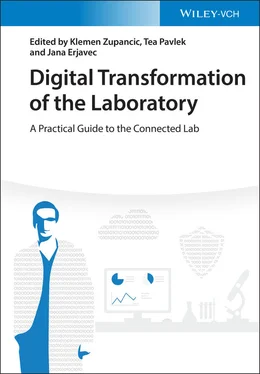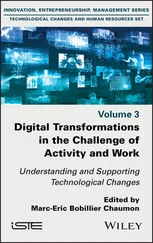1 Cover
2 Title Page Digital Transformation of the Laboratory A Practical Guide to the Connected Lab Edited by Klemen Zupancic Tea Pavlek Jana Erjavec
3 Copyright The Editors Klemen Zupancic SciNote LLC 3000 Parmenter St. 53562 Middleton WI United States Tea Pavlek SciNote LLC 3000 Parmenter St. 53562 Middleton WI United States Jana Erjavec BioSistemika LLC Koprska ulica 98 1000 Ljubljana Slovenia Cover Image: Tea Pavlek All books published by WILEY-VCH are carefully produced. Nevertheless, authors, editors, and publisher do not warrant the information contained in these books, including this book, to be free of errors. Readers are advised to keep in mind that statements, data, illustrations, procedural details or other items may inadvertently be inaccurate. Library of Congress Card No.: applied for British Library Cataloguing-in-Publication Data A catalogue record for this book is available from the British Library. Bibliographic information published by the Deutsche Nationalbibliothek The Deutsche Nationalbibliothek lists this publication in the Deutsche Nationalbibliografie; detailed bibliographic data are available on the Internet at < http://dnb.d-nb.de >. © 2021 WILEY-VCH GmbH, Boschstr. 12, 69469 Weinheim, Germany All rights reserved (including those of translation into other languages). No part of this book may be reproduced in any form – by photoprinting, microfilm, or any other means – nor transmitted or translated into a machine language without written permission from the publishers. Registered names, trademarks, etc. used in this book, even when not specifically marked as such, are not to be considered unprotected by law. Print ISBN: 978-3-527-34719-3 ePDF ISBN: 978-3-527-82505-9 ePub ISBN: 978-3-527-82506-6 oBook ISBN: 978-3-527-82504-2
4 Preface Preface The subject of digital transformation is actually about you. Your science, your everyday work environment, your partnerships and collaborations, and the impact of your work on the future of scientific progress. Welcome to this book. As a brilliant astronomer, Maria Mitchell once said, “mingle the starlight with your lives and you won't be fretted by trifles.” The greater meaning of digital transformation shifts the perspective toward the global scheme of things. The main evaluating factors behind the lab digitalization and digital transformation answer important questions: Are we improving the quality, efficiency, and the pace of innovation? Lab digitalization is a people‐driven initiative that aims to address the global challenges and provide solutions, backed by unquestionable integrity of traceable and reproducible scientific data. At the moment, regardless of the laboratory type or size, people are struggling with the growing amount of generated data and leveraging its value. It is extremely challenging to organize data and keep everything traceable and reusable long term. To address the challenge, modularity and flexibility are being incorporated on different levels of lab operations. Labs are becoming inviting spaces suitable for interdisciplinary partnerships in a digital, virtual, or personal environment. Data integrity initiatives and setup of new, digital systems prioritize integration of all tech solutions used in the lab for optimal performance. Through effective integration of tools, improved scientist‐to‐scientist interactions and intellectual contributions, and quality change management, lab digitalization places the human element at the very forefront of the overall progress toward the digital future. This can be intimidating to some and exhilarating to others. That is why this book is divided into modules: Inspiration, Knowledge Base, Practical, Case Studies, Continuous Improvement, and Vision of the Future. Each module covers different aspects of lab digitalization.
Inspiration Inspiration We start this book with an inspiring overview of lab evolution, new technologies, and new science being done. It will give you a complete overview of the subject of laboratories of the future and, hopefully, add to the vision of your own career in science and technology.
Knowledge Base Knowledge Base Knowledge Base section focuses on crucial terms to understand. It will give you a solid basis of knowledge that you will be able to apply further on as your lab grows and evolves.
Practical Practical The Practical chapters give you examples and guidance on defining your lab's digitalization strategy.
Case Studies Case Studies We present different case studies and expert comments on the subject of going from paper to digital. You will be able to read how different laboratories and professionals approached the subject and put it into practice, and what are their conclusions, advice, and lessons learned.
Continuous Improvement Continuous Improvement We have a closer look at the steps that follow after the digitalization.
Vision of the Future and Changing the Way We Do Science
5 Part I: Inspiration 1 The Next Big Developments – The Lab of the Future 1.1 Introduction 1.2 Discussion 1.3 Thoughts on LotF Implementation 1.4 Conclusion References
6 Part II: Knowledge Base 2 Crucial Software‐related Terms to Understand 2.1 Digital Revolution 2.2 Computers 2.3 Internet 2.4 Cloud Computing 2.5 Computer Platforms 2.6 Applications 2.7 Values of Software 2.8 Software Development 2.9 Software Product Lifecycle 2.10 Software Design 2.11 Software Quality 2.12 Software Integration 2.13 Data‐flow Modeling for Laboratories 2.14 Software Licensing References 3 Introduction to Laboratory Software Solutions and Differences Between Them 3.1 Introduction 3.2 Types of Software Used in Laboratories References 4 Data Safety and Cybersecurity 4.1 Introduction 4.2 Data Safety 4.3 Cybersecurity References 5 FAIR Principles and Why They Matter 5.1 Introduction 5.2 What Is the Value of Making Data FAIR? 5.3 Considerations in Creating Lab‐based Data to Prepare for It to Be FAIR 5.4 The FAIR Guiding Principles Overview References 6 The Art of Writing and Sharing Methods in the Digital Environment 6.1 Introduction 6.2 Tools and Resources for Tracking, Developing, Sharing, and Disseminating Protocols 6.3 Making Your Protocols Public 6.4 The Art of Writing Methods References
7 Part III: Practical 7 How to Approach the Digital Transformation 7.1 Introduction 7.2 Defining the Requirements for Your Lab 7.3 Evaluating the Current State in the Lab References 8 Understanding Standards, Regulations, and Guidelines 8.1 Introduction 8.2 The Need for Standards and Guidelines 8.3 How Does Digitalization Relate to Standards and Guidelines 8.4 Challenges Related to Digitalization in Certified Laboratories 8.5 Can Digital Strategy be Implemented without Certification? References 9 Interoperability Standards 9.1 SiLA 9.2 AnIML 9.3 Allotrope 9.4 Conclusion 10 Addressing the User Adoption Challenge 10.1 Introduction 10.2 Identify Key Stakeholders and Explain the Reasons for Change 10.3 Establish a Steering Committee 10.4 Define the Project Objectives, Expected Behaviour, and Timeline 10.5 Check for Understanding and Encourage Debate 10.6 Acknowledge Ideas and Communicate Progress 10.7 Provide a Feedback Mechanism 10.8 Set Up Key Experience Indicators and Monitor Progress 10.9 Gradually Expand to a Larger Scale 10.10 Conclusions References 11 Testing the Electronic Lab Notebook and Setting Up a Product Trial 11.1 Introduction 11.2 The Product Trial 11.3 The Importance of a Product Trial 11.4 Setting Up a Product Trial 11.5 Good Practices of Testing a Product 11.6 Conclusions References
8 Part IV: Case Studies 12 Understanding and Defining the Academic Chemical Laboratory's Requirements: Approach and Scope of Digitalization Needed 12.1 Types of Chemistry Laboratory 12.
Читать дальше











